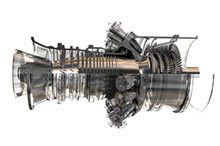Integrating wind and solar power
 GE's new technologuy may not be the ideal complement to renewable energy, but it does represent a step in the right direction. (GW)
GE's new technologuy may not be the ideal complement to renewable energy, but it does represent a step in the right direction. (GW)GE Combines Natural Gas, Wind, and Solar
The hybrid plant could be the cheapest and easiest way to add renewable energy to the grid.
By Kevin BullisTechnology Review
June 6, 2011
GE has announced the first power plant to integrate wind and solar power with natural gas—a 530-megawatt plant that will start operating in Turkey in 2015. The power plant is made practical by a flexible, high-efficiency natural-gas system the company announced two weeks ago and a solar thermal power system created by eSolar, a Burbank, California-based startup that GE recently invested in.
Such hybrid plants may become the dominant type of new power plant in some parts of the world, GE says. The new technology is aimed at countries that use 50 hertz electricity (the United States uses 60 hertz). In particular, it could make it easier for China and the European Union to meet their renewable energy targets.
Adding solar power to natural gas plants isn't a new idea, but it hasn't been economical without government subsidies. GE says that because of its new turbines and related equipment, these hybrid plants can, for utilities with the right combination of sunlight and natural gas prices, be competitive even without government support.
While combining solar thermal power and natural-gas turbines is not new, adding wind power to such a system is, GE says. Pairing wind with the natural gas plant helps shave some of the cost of the wind power—the wind farm can share some of the natural gas plant's control systems and its connection to the grid. The natural gas plant also smooths out variations from the wind turbines.
Solar thermal power involves the use of an array of mirrors to concentrate sunlight and the resulting heat to produce steam. That steam can be fed into the steam turbine at a natural gas combined cycle plant to boost its power output.
The solar concentrator array from eSolar helps lower costs in two ways—its modular concentrator system is easy to install and easy to modify for the needs of specific plants. It also produces higher temperature steam than some previous solar thermal systems, increasing power output. GE has also developed a natural gas power plant that is highly efficient, and whose power output can easily be adjusted to make up for variations in power output from solar power.
Connecting a solar thermal system to a natural gas power plant, and thus eliminating the need to buy a separate steam turbine and related equipment, can cut the cost of a solar thermal system by up to 50 percent, says Jon Van Scoter, CEO and president of eSolar. Paul Browning, vice president of thermal products at GE, calls it "the most cost-effective form of solar energy available today."
Copyright Technology Review 2011.

0 Comments:
Post a Comment
<< Home